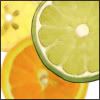
It strikes me a woeful time indeed when simple salt and vinegar potato chips must be given their tangy taste with artificial salt and vinegar flavoring. Yes, that's right. Per the package, which claims that they are artificially flavored, the ingredients include:
Salt & Vinegar Seasoning (Lactose, and less than 2% of the Following: Sodium Diacetate, Maltodextrin, Salt, Partially Hydrogenated Cottonseed and Soybean Oil, Malic Acid, Sodium Citrate)
Hmm. So their salt and vinegar seasoning
contains no true table salt *See correction below* (for those of you who've forgotten some of your basic chemistry, salt is sodium chloride), and no vinegar (which is water and acetic acid). No, the common flavoring of most salt and vinegar chips, I discovered, is sodium diacetate itself - a sodium salt of acetic acid. This is amusing, since most 'natural' chips I have had have been flavored with salt (usually sea salt) and vinegar. Apparently, though, the big brands want to go for more "tang" for their buck.
While browsing around the internet with interest in this, I happened upon
The Salt and Vinegar Pringle Experiment. The short of it is, these chips (by the way, my offender today is Lays brand, not Pringles, and the ingredients are different in some subtle ways) contain powdered acids on their surface to give them their flavor. The chips create a liquid acid on your lips, mouth, and tongue - an acid that can actually burn you if you do not wash it away with liquid (ie, drink.) The chips, in other words, end up being more acidic than drinking straight vinegar.
While I'm not going to give up my bag of Lays for a cup of vinegar, I can't deny that I'm a little wary of eating these kinds of chips anymore (at least the ones with artificial flavoring). In a way, the whole thing - powdered acid to create a liquid acid in your mouth, thereby creating a flavorful "stinging" sensation - reminds me of drug consumption. No, I'm not implying these companies are trying to drug us (else salt & vinegar would be far more popular as a potato chip flavor.) What I'm referring to is the ingestion of a natural or altered natural substance in order to experience the thrill of the sensations it brings. Think of ultra-sour candies, hot sauces that top the Scoville scale - or better yet, think of a super-fast roller coaster. Roller coaster fans, like many drug consumers, take their rides not for the appreciation of the coaster itself (the "taste" of the drug), but for the thrill of the ride itself, the fear and anticipation it causes, the way it kicks in their fight-or-flight reflexes (the reaction the drug causes, such as hallucinations).
Salt & Vinegar Potato Chips are the same way; they do not stimulate our tastes so much as elicit a reaction of pain (albeit mild mannered). Are those of us who love these chips not attracted to their flavor, but instead, secretly thrill eaters, slightly sadomasochistic - at least with our food? Is that why, even as we eventually experience those small burns from time to time after ingesting a batch, we continue to return to them, knowing well the risks of another injury? Or are we just deluding ourselves that this combination of acids is actually the flavor of salt and vinegar?
* 11/8/07 Correction: I mis-stated this, and I apologize. I did not mean that the chips used no salt; rather that the "flavoring" was not a combination of salt and vinegar (as competing chip brands use). In my haste, I made an error.


